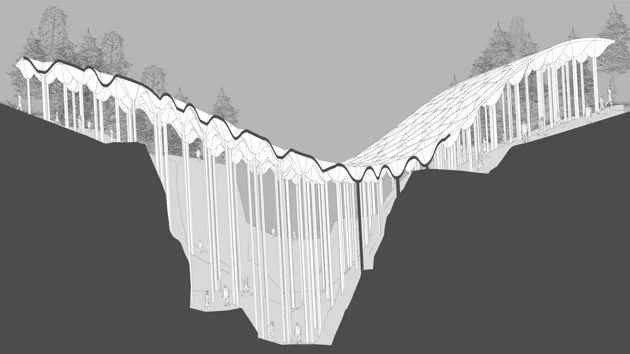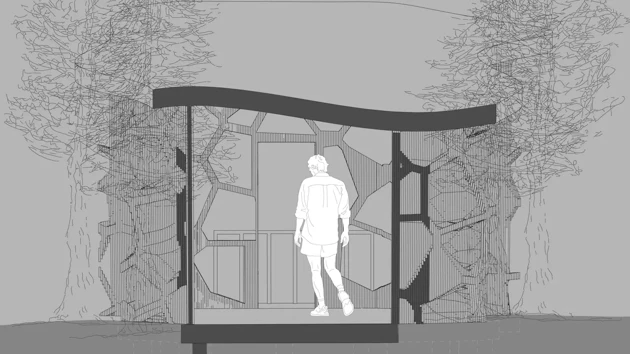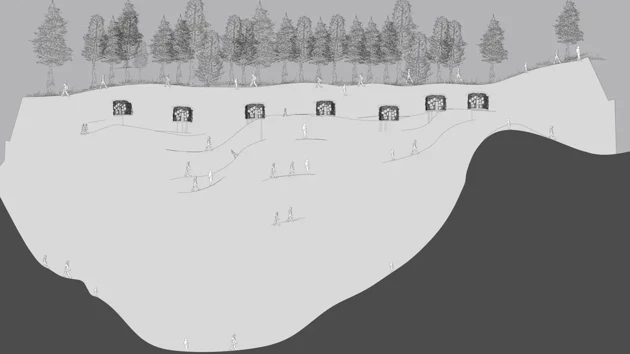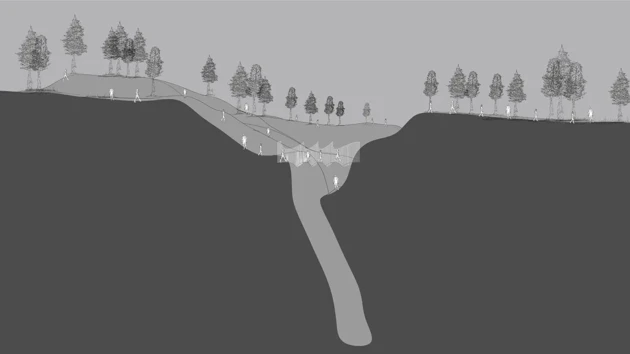A Section of the Superstructure that is situated on Kedträskgruvan (the second mine as part of the site). The structure allows for flora and fauna to grow directly onto the structure over time. This acts as the second intervention as to how architects can intervene into abandoned mining landscapes.
Mining as A Void
This project seeks to act as the foundations for how architects and spatial planners can utilise abandoned mining landscapes as architectural and spatial interventions. While the thesis looks at two mining landscapes one abandoned and one in use and analyses their spatial logic with the intersections of class, culture and historical heritage.
Mining is a dynamic and fluid act that traverses a variety of scales, both in the spatial sense as well as the social and cultural sense. It is not simply an industry that requires the act of digging and excavating, but is rather a process that has the capacity to create not only space, but also communities and the way in which they operate. Additionally, mining is an industry that reflects capitalist and neoliberal globalised flows of production which means they are essential and have strategic significance within planning and urban design on increasingly global scales. Therefore, mining landscapes have a distinct urbanisation pattern that falls outside the discussion of mainstream urbanisation of dwelling discourse, which provides the foundations as to the importance of why spatial practitioners should explore these landscapes, and what insights they can provide in both architectural and anthropological aspects.
But what happens when these landscapes are abandoned? Should we just flood them and leave them to fall outside of our consciousness? Does that mean their cultural significance and architectural potentialities wither away? How can we build upon what was once there? How do we allow for both humans and nature to integrate with the scars the mine has left behind?
These questions act as the foundation for the project. Using forensic forms of architectural enquires and techniques, this project has reconstructed a network of abandoned mines along the Skellefteälv, to then speculate minimal interventions that could be implemented onto them. This is enacted through the application of a pilgrimage above, around and through the mines, in which both humans and nature act as the participants. Using studies of the ground, casting methods and growth networks, this project aims to reveal and expose the stark nature of abandoned mines and reintegrate them into our public consciousness.
Studio 12: Man-Made Geographies: From Planetary to Molecular
Studio Teachers: Alejandro Haiek Coll (Studio Coordinator), Johanna Runge, Raffaelle Enrichiello


A Section of a Cabin that is situated on Uddengruvan (the first mine as part of the site). The structure allows for both flora and fauna to grow directly onto the structure; thus, both humans and nature are the residents. This acts as the first intervention as to how architects can intervene into abandoned mining landscapes.

A Section of the series Cabin that is situated on Uddengruvan (the first mine as part of the site). The structure allows for both flora and fauna to grow directly onto the structure; thus, both humans and nature are the residents. This acts as the first intervention as to how architects can intervene into abandoned mining landscapes.

A Section of a Bridge that is situated on Åsengruvan (the third mine as part of the site).



